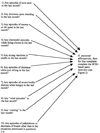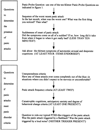Panic disorder among Cambodian refugees attending a psychiatric clinic. Prevalence and subtypes
- PMID: 11072060
- PMCID: PMC2749726
- DOI: 10.1016/s0163-8343(00)00102-x
Panic disorder among Cambodian refugees attending a psychiatric clinic. Prevalence and subtypes
Abstract
This study surveys Khmer refugees attending two psychiatric clinics to determine both the prevalence of panic disorder as well as panic attack subtypes in those suffering panic disorder. A culturally valid adaptation of the SCID-panic module, the Cambodian Panic Disorder Survey (CPDS), was administered to 89 consecutive Cambodian refugees attending these psychiatric clinics. Utilizing culturally sensitive panic probes, the CPDS provides information regarding both the presence of panic disorder and panic-attack subtypes during the month prior to interview. Of 89 patients surveyed at two psychiatric clinics, 53 (60%) currently suffered panic disorder. Among the 53 patients suffering panic disorder, the most common panic attack subtypes during the previous month were the following: "sore neck" [51% of the 53 panic disorder patients (PDPs)], orthostatic dizziness (49% of PDPs), gastrointestinal distress (26% of PDPs), effort induced (21% of PDPs), olfactory induced (21% of PDPs), and "while-sitting dizziness" (16% of PDPs).
Figures
Similar articles
-
Panic disorder among Vietnamese refugees attending a psychiatric clinic: prevalence and subtypes.Gen Hosp Psychiatry. 2001 Nov-Dec;23(6):337-44. doi: 10.1016/s0163-8343(01)00163-3. Gen Hosp Psychiatry. 2001. PMID: 11738465 Free PMC article. Review.
-
A unique panic-disorder presentation among Khmer refugees: the sore-neck syndrome.Cult Med Psychiatry. 2001 Sep;25(3):297-316. doi: 10.1023/a:1011848808980. Cult Med Psychiatry. 2001. PMID: 11680477
-
The panic attack-posttraumatic stress disorder model: applicability to orthostatic panic among Cambodian refugees.Cogn Behav Ther. 2008;37(2):101-16. doi: 10.1080/16506070801969062. Cogn Behav Ther. 2008. PMID: 18470741 Free PMC article. Clinical Trial.
-
Olfactory-triggered panic attacks among Cambodian refugees attending a psychiatric clinic.Gen Hosp Psychiatry. 2004 Sep-Oct;26(5):390-7. doi: 10.1016/j.genhosppsych.2004.04.007. Gen Hosp Psychiatry. 2004. PMID: 15474639
-
[Panic disorder].Nihon Rinsho. 1994 May;52(5):1334-8. Nihon Rinsho. 1994. PMID: 8007410 Review. Japanese.
Cited by
-
Mechanisms of efficacy of CBT for Cambodian refugees with PTSD: improvement in emotion regulation and orthostatic blood pressure response.CNS Neurosci Ther. 2009 Fall;15(3):255-63. doi: 10.1111/j.1755-5949.2009.00100.x. CNS Neurosci Ther. 2009. PMID: 19691545 Free PMC article. Clinical Trial.
-
Olfactory-triggered panic attacks among Khmer refugees: a contextual approach.Transcult Psychiatry. 2004 Jun;41(2):155-99. doi: 10.1177/1363461504043564. Transcult Psychiatry. 2004. PMID: 15446720 Free PMC article.
-
Somatic panic-attack equivalents in a community sample of Rwandan widows who survived the 1994 genocide.Psychiatry Res. 2003 Jan 25;117(1):1-9. doi: 10.1016/s0165-1781(02)00301-3. Psychiatry Res. 2003. PMID: 12581815 Free PMC article.
-
Mental Health and Relational Needs of Cambodian Refugees after Four Decades of Resettlement in the United States: An Ethnographic Needs Assessment.Behav Sci (Basel). 2024 Jun 26;14(7):535. doi: 10.3390/bs14070535. Behav Sci (Basel). 2024. PMID: 39062358 Free PMC article.
-
Panic probes and the identification of panic: a historical and cross-cultural perspective.Cult Med Psychiatry. 2002 Jun;26(2):137-53. doi: 10.1023/a:1016359531483. Cult Med Psychiatry. 2002. PMID: 12211322
References
-
- Kinzie J, David J, Boehnlein P, Leung L, Moore L, Riley C, Smith D. The prevalence of posttraumatic stress disorder and its clinical significance among southeast asian refugees. Am J Psychiatry. 1990;147:913–917. - PubMed
-
- Carlson EB, Rosser-Hogan R. Trauma experiences, post-traumatic stress, dissociation, and depression in Cambodian refugees. Am J Psychiatry. 1991;148:1548–1551. - PubMed
-
- Kroll J, Hebenicht M, Mackenzie T, et al. Depression and posttraumatic stress disorder in southeast asian refugees. Am J Psychiatry. 1989;146:1592–1597. - PubMed
-
- Mollica RF, Wyshak G, Lavelle J. The psychosocial impact of war trauma and torture on southeast asian refugees. Am J Psychiatry. 1987;144:1567–1572. - PubMed
-
- Hinton WL, Chen YC, Nang D, et al. DSM-III-R disorders in Vietnamese refugees: prevalence and correlates. J Nerv Ment Dis. 1993;181:113–122. - PubMed
MeSH terms
Grants and funding
LinkOut - more resources
Full Text Sources
Medical



